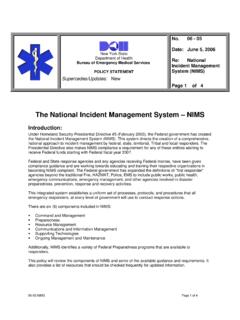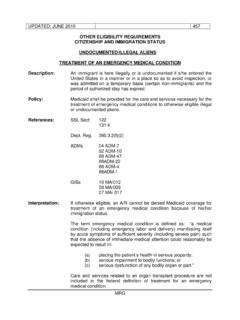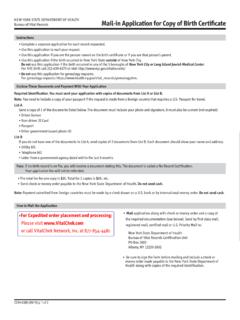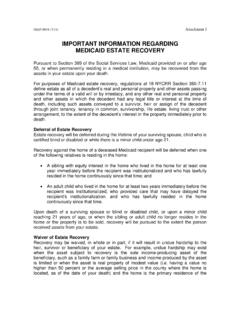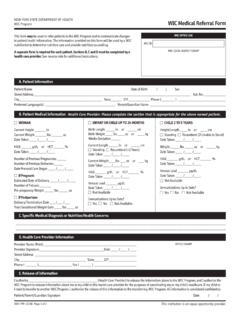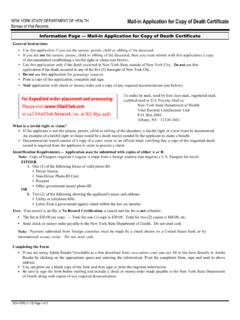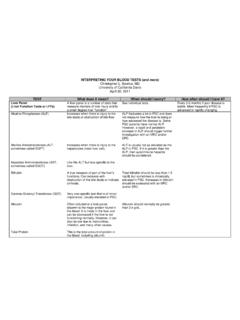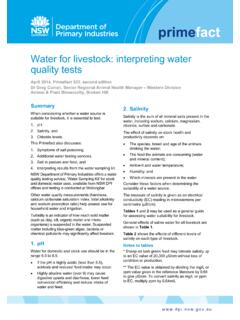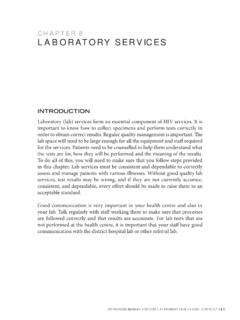Transcription of Blood Work: A Complete Guide for Monitoring HIV
1 - -- -- Blood work : A Complete Guide FOR Monitoring HIV Lab tests , or Blood work , can give im portant clues about your overall health and HIV disease. Many of these tests should be done shortly after learning that you re HIV-positive. This will establish a baseline measure of your immune health and show how active HIV is. Knowing this information will help you watch for changes in your health over time as well as check the impact of any treatments that you take. Factors such as age, gender, stress, medicines, active infections and others can all affect these test results. Lab results should be considered with these factors in mind. Understanding your test results may seem difficult at first. However, they can help you take charge of your health and understand why your doctor prescribes certain tests and medicines.
2 With practice over time, it becomes easier to understand these results. PUBLISHED BY JANUARY 2011 Nearly all lab reports make it simpler to understand test results by including a normal range, or high and low values. The results that fall outside normal ranges are likely the most important ones. Those that are above or below normal are often highlighted on your lab report by being bolded, printed in a different color or printed in a different column. It is your right to have and keep copies of all of your medical records. You can then keep track of your results to look for overall trends. Ask for and keep copies of your lab reports, and make a chart or table of them to note trends or changes. For examples of these charts, read Project Inform s publication, Personal Tracking Charts, available at 1-800-822-7422 or WHAT S INSIDE Complete Blood count: 3; Platelet count: 3; What do CD4+ cell counts mean?
3 : 3; Red Blood cells: 4; White Blood cells: 5; Chemistry screen: 6 7; Lymphocyte subsets and viral load: 8 9; Resistance tests : 9; Other tests that may be done: 10; Table of common tests and ranges: 11; Interpreting your viral load numbers: 12. PROJECT INFORM 1375 MISSION STREET SAN FRANCISCO, CA 94103 2621 415 558 8669 FAX 415 558 0684 - --- -- 4 5 3 21 B L O O D W O R K . P R O J E C T I N F O R M 2 Normal test values can differ. For example, lower cholesterol values may be considered normal in an HIV-positive person not on HIV treatment. Be sure to discuss these dif ferences with your doctor.
4 Test results outside the lab s normal range may not be cause for alarm. Different labs can get different results from the same Blood sample because they use different methods or equipment. If for some reason you cannot use the same lab, you may need to establish a new baseline at the new lab. In the case of viral load tests , try to have the same type of test (bDNA, PCR, etc.) done each time. If your doctor sends you to the same place to give Blood for test ing, it s likely the same labs and types of tests are being used. If you move or if you change doctors or health plans, it s a good idea to check and see if your lab has changed as well. If you ever see dramatic changes in your lab results, you might ask your doctor if the lab or type of test have changed. Several things can impact your test results. For example, they can vary due to the time of day your Blood is drawn.
5 If possible, try to schedule Blood draws at the same time of day every time. If you re sick or have an infection, like a cold or flu, these can also affect your test results. You may want to wait to have lab work done or repeat the tests after you ve become well again. Getting a flu shot or other vaccination can also alter lab results, as it stimulates the immune system and can increase how active HIV becomes. HIV levels usually return to baseline within a month after a vaccination. A dramatic change in results may be due to testing errors. As for CD4 cell counts and HIV levels, it s wise to have the test run again and to not make therapy decisions from any one test result. No single test result provides all the answers. Most results need to be considered along with other reports and within the context of your overall health.
6 Although this publication may seem long and involved, it gives a thorough background to the types of tests that you may need to take over time. There are 5 key points to keep in mind when reading this material: TOLL FREE HIV HEALTH INFOLINE 1 800 822 7422 LOCAL & INTERNATIONAL 415 558 9051 MONDAY FRIDAY 10 4 PACIFIC TIME - -- -- Complete Blood count (CBC) The CBC is the most common Blood test that doctors order. It checks levels of white Blood cells, red Blood cells and platelets. Generally, even people without symptoms of HIV disease should have a CBC test done at least every 6 12 months. People whose Blood work trends are changing may want to have their CBCs done every three months, or more often.
7 People with symptoms of HIV disease should have a CBC every 3 6 months. CBC testing is done more often in people with symptoms of low red Blood cells (anemia), low white Blood cells (leukopenia) and low platelets (thrombocytopenia). In each case, if a change occurs that worries you or your doctor, the tests should be done again a few weeks later. Of the tests explained in this publication, the most important ones are the red Blood cell, white Blood cell and platelet counts. Platelet count Platelets are the part of the Blood that helps it to clot. They travel to the site of an injury where they stick and help develop a clot or scab to stop the bleeding. A normal count is 150,000 440,000. A low count can be caused by HIV infection or by some drugs. Although a platelet count below 150,000 is considered low, most people are not at risk of uncontrolled bleeding with counts of 50,000 or even lower.
8 However, because platelets are necessary for Blood clotting, the chance of major bleeding rises as the platelet count drops. If your platelet count is very low (in the 10,000 range) and/or you have symptoms related to thrombocytopenia, your doctor may want to change your treatment, or may teach you special ways to prevent bleeding. Above 500 CD4+ cells No unusual conditions likely. Emphasize good health habits and health care maintenance, including vaccines and nutrition. 200 500 CD4+ cells Increased risk for shingles (zoster), thrush (candida), skin infections, bacterial sinus and lung infections, and TB. Life-threatening OIs (such as PCP, MAC and CMV) are rare. HIV treatment is generally sug-gested at 300-500 CD4s and recommended when CD4 cell counts falls to 200 to 350. 50 200 CD4+ cells Increased risk for PCP and other life-threatening OIs.
9 Preventive treatment for PCP is indicated. If counts are below 100, con-sider preventive treatment for MAC, CMV and invasive fungal infections. Below 50 CD4+ cells Increased risk for OIs, includ-ing MAC and CMV. Continue preventive medica-tions. B L O O D W O R K . P R O J E C T I N F O R M 3 PROJECT INFORM 1375 MISSION STREET SAN FRANCISCO, CA 94103 2621 415 558 8669 FAX 415 558 0684 - --- -- Red Blood cells: the oxygen carriers Hematocrit The hematocrit is another way to measure RBCs. It is the percentage of Blood cells in your body that are red Blood cells. Normal values range in men from 40 54% and in women 37 47%. Hematocrit values indicate the thickness of the Blood as well as its ability to carry oxygen.
10 A low hematocrit also indicates anemia. Mean Corpuscular Volume (MCV) The MCV measures the average size of red Blood cells. The average MCV ranges from 80 100 femtoliters (fL). A low MCV shows that cells are smaller than normal. This may be due to an iron deficiency or chronic disease. MCV is generally higher than normal in people taking Retrovir (zidovudine, AZT) or in people with vitamin B12 and folic acid deficiencies. Mean Corpuscular Hemoglobin (MCH) and Mean Corpuscular Hemoglobin Concentration (MCHC) These measure the amount and volume of hemoglobin in an average cell. These are less important but help to detect various anemias and leukemias. 4 B L O O D W O R K . P R O J E C T I N F O R M Red Blood Cell (RBC) Count RBCs are produced in your bone marrow, and they carry oxygen and carbon dioxide through your body.

